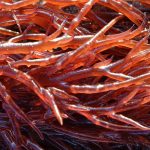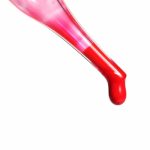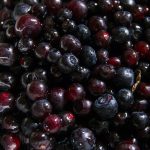
Quite often in US and European food formulations you will see a number of artificial colours. One in particular is Allura Red AC which is a red azo dye with exceptional stability. It’s also known as FD&C Red 40 and has been a food dye for many years. The dye belongs to a group commonly called sulphonated mono azo dyes.
It has the E number E129 and is permitted in the European Union as a food additive.
The IUPAC name is disodium 6-hydroxy-5-[(2-methoxy-5-methyl-4-sulfonatophenyl)diazenyl]naphthalene-2-sulphonate. It is CAS No. 25956-17-6.
The dye is available as a mineral salt with sodium, calcium and potassium and sometimes with all three in the mix. The addition of the mineral helps make it extremely soluble. The dye was first introduced into the USA as a food colouring agent in 1971.
Sometimes it is prepared as a lake where it is then labelled as Red 40 Aluminium lake or just Red 40 Lake. In the USA is it is permitted in cosmetics, food and many drugs. It is also a tattoo ink. Some of the most popular products containing this dye include beverages, especially soft drinks and those aimed at children. It is now the most popular red colour in general use in the USA and more popular than amaranth (Red 2) and erythrosine (Red 3).
The colour is produced from petroleum distillates and coal tars.
In general most food businesses are committed to removing synthetic dyes because of the adverse publicity and seeking out natural red colours. Typical natural red colours come from anthocyanins in blackcurrant, cherry, black carrot and many different fruits. Betaine from beetroot has also been exploited as a natural red colouring.
Health & Safety Of Allura Red
The ADI (acceptable daily intake) is 7mg/kg body weight.
The dye along with five others made the headlines back in 2007 where they became known as the ‘Southampton Six’ group of colours. The study published in 2007 in The Lancet had linked synthetic or artificial colours with increased hyperactivity in children. At the time EFSA examined the data and could not draw any firm conclusions about individual colours because combinations of dyes had been used making it impossible to attribute any effects to any one particular ingredient. The ADI on three of the other ingredients was changed but not because of any effects causing or increasing hyperactivity.
Allura red AC can form a complex with human serum albumin (HSA) although albumins are common carriers of a variety of materials in the blood system. Allura Red AC would on this basis make an effective ligand for general affinity chromatography (Wu et al., 2015). The binding is reversible.
The dye is non-genotoxic in a wide range of gene mutation tests which involved both prokaryotic and eukaryotic cells and irrespective of the use of activation or not (Chung et al., 1981; Combes & Haveland-Smith, 1982). The dye was however reported to show a direct genotoxic effect when different concentrations of the dye ranging from 9.76 to 5000 µg/mL was incubated with a culture of Saccharomyces cerevisiae at 37°C. Comet assay revealed dose-related DNA damage starting at concentration of 1250 μg/ml, though no positive correlation could be established with exposure time (Jabeen et al., 2013).
The European Food Safety Authority (EFSA) has routinely assessed the exposure data for many common synthetic dyes used in foods. It was assessed in 2009 which at the time noted that children between the ages of 1 and 10 could exceed the ADI level of 7mg/kg body weight because they were one of the highest consumers of foods that contained this colouring. EFSA then began a new and refined exposure assessment in 2013 following the publication of new data and findings.
The new (2013-2015) (EFSA, 2015) assessment looked at revised usage data for 6 of the 51 food categories where the colour is authorised as a food additive and at analytical and additional safety data from the memeber states of the European Union for 35 of the food categories. The new EFSA study was published in 2015 and has not changed its opinion – “none of the exposure estimates exceeded the ADI of 7 mg/kg bw per day in any population”. It means the current intakes are still safe for the dye to be consumed.
In 2017, the International Association of Color Manufacturers (IACM) also published an assessment which supported the USA’s FDA and EFSA findings on synthetic colours. The IACM study looked at the safety profiles of Tartrazine (E102) and Allura Red AC (E129) in the general US populations and concluded they “did not pose a health risk at conservative ranges of food consumption and levels of use.”
The researchers looked at various populations including children in the age brackets of 2 to 5 years old and 6 to 12 years old, adolescents between 13 and 18 and adults of 19 years or greater. The research included food consumption information from the National health and Nutrition Examination Survey (NHANES). The research also used collected data from an industrial survey from companies on the users of various colour additives in a range of food products. Additional information was taken from food colouring producers.
There were two separate studies conducted in mice on exposure to Allura Red and Tartrazine in a response to an information request by EFSA (Bastaki et al., 2017a, b). These were conducted by the IACM who funded the research. In these studies, the mice were given three dose levels of the additives ( 25, 500 and 2000 milligrams per kilogram (mg/kg) body weight on three consecutive days (initial time zero, 24 and 45 hours). The research group chose dosage levels for various dyes based on a comet assay and examined organ damage (Sasaki et al., 2002). The main measure of genotoxicity was negative for the effects of the two dyes on various organs including colon, stomach and liver.
In the USA, the IACM also looked at daily intake levels of colour additives an synthetic food colours to establish an estimated daily intake (EDI). These additives included Allura Red, Tartrazine, erythrosine, Fast Green, Brilliant Blue, Indigo Carmine and Sunset yellow amongst others (Bastaki et al., 2017c).
On the basis of the IACM findings, the IACM was able to state that:-
“Continued use of these synthetic colour additives is safe even with high intake levels, which still register far below the safe daily level established by expert bodies such as the joint FAO/WHO Expert Committee on Food Additives (JECFA).”
References
Bastaki, M., Farrell, T., Bhuasari, S., Pant, K., Kulkarni, R. (2017a) Lack of genotoxicity in vivo for food color additive Allura Red AC. Food Chem. Toxicol. 105 pp. 308 – 314 (Article)
_________________________________________ (2017b) Lack of genotoxicity in vivo for food color additive Tartrazine. Food Chem. Toxicol. 105 pp. 278-284
_______________________________, Bi, X., Scrafford, C. (2017c) Estimated daily intake and safety of FD&C food-colour additives in the US population. Food Addit. Contam.: PartA 34 (6) (Article)
Chung, K.T., Fulk, G., Andrews, A. (1981). Mutagenicity testing of some commonly used dyes. Appl. Environ. Microbiol. 42(4) pp. 641-648
Combes, R.D., Haveland-Smith, R.B. (1982). A review of the genotoxicity of food, drug and cosmetic colours and other azo, triphenylmethane and xanthene dyes. Mutat. Res. 98(2) pp. 101-243
EFSA (2015) Refined exposure assessment for Allura Red AC (E 129). EFSA Journal (Article)
Jabeen, H.S., ur Rahman, S., Mahmood, S., Anwer, S. (2013). Genotoxicity assessment of amaranth and allura red using Saccharomyces cerevisiae. Bull. Environ. Contam. Toxicol. 90(1) pp. 22-26
Sasaki, Y.F., Kawaguchi, S., Kamaya, A., et al., (2002) The comet assay with 8 mouse organs: results with 39 currently used food additives. Mutat. Res. 519(1-2) pp. 103-119
Wu, D., Yan, J., Wang, J., Wang, Q., & Li, H. (2015). Characterisation of interaction between food colourant allura red AC and human serum albumin: Multispectroscopic analyses and docking simulations. Food Chemistry, 170, pp. 423-429 (Article)



Leave a Reply